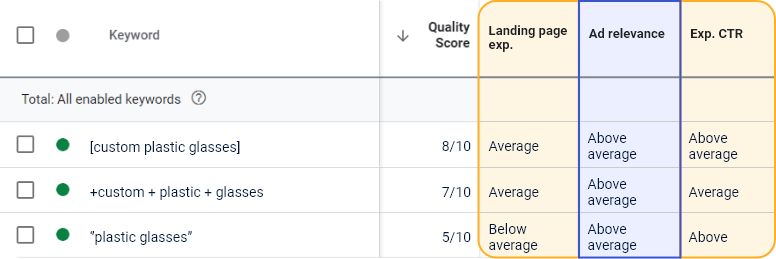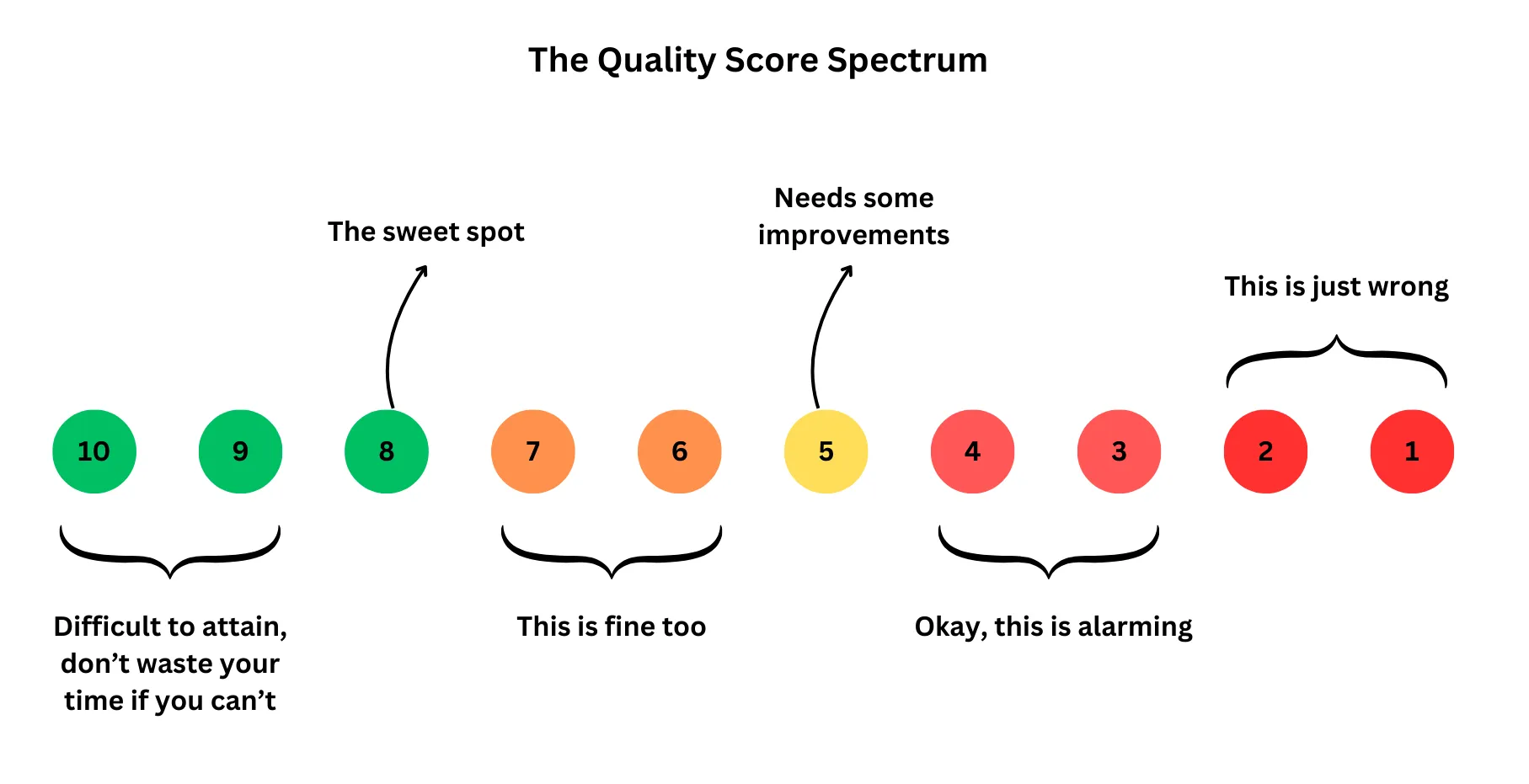When you start running your campaigns, Google learns about your services, ad targeting, and how users are interacting with your ads. Through these understandings, Google Ads determines your ad relevancy, performance, and most importantly, the quality score. Let’s talk about it.
What is Google Ads Quality Score and why it matters
Google Ads Quality Score is a metric (scored from 1 to 10) used to measure the relevance and effectiveness of your ads, keywords, and landing pages. It’s calculated based on three key factors:
- Expected click-through rate (CTR)
- Ad relevance
- Landing page experience
This score helps determine your Ad Rank and cost per click (CPC), which means a higher score can lead to better ad placement at a lower cost.
How is the quality score calculated?
Quality score is usually calculated based on 3 factors:
- Expected click-through rate (CTR): This is a measure of how likely are people to click on your ad when it shows on SERPs.
- Ad relevance: This is an indicator of how closely your ad matched the user intent behind the search.
- Landing page experience: This is a measure of how relevant and useful your landing page is to people who click on your ad and visit your landing page.
How to check your Google Quality Score
You can find the Quality Score for each keyword in your Google Ads account. It breaks down how your ad ranks in terms of relevance and user experience, helping you spot areas for optimization— whether it’s the ad copy, keyword targeting, or your landing page content.
However, to understand how Google Quality Score works and its true impact, we need a quick refresher on how Google Search ads work.

Quality Score on Google Ads
How Google search ads work
Google Ads is a PPC advertising platform that allows advertisers to show their ads across the Google network which includes search results, ad spaces on websites, and applications. For this blog, we’ll stick to Google search ads and learn how to improve Google ads quality score.
Google search ads
Search ads appear on Google’s search results or on the search engine results page (SERPs) - based on targeted keywords.
This means that when a user searches for something on Google if the keywords are relevant to the ones added to your Google Ads campaign, your ads will show up.
But it’s not exactly that straightforward. Certain factors come into play, including the quality score for your keywords.
But first, let’s look through some of the basics:
- Ads appear on: Search Results Page (SERPs), Partner Websites, Applications
- Key factors: Keyword Targeting, Quality Score
Bidding
When multiple brands compete to show ads for the same keywords, Google Ads uses a bidding algorithm to determine each search ad's rank. While ad relevancy and quality score also affect ranking, let's first understand how bidding works.
Bidding is for you to help Google Ads understand your goals or objectives for the campaign. This helps optimize your campaigns and improve the results you see over time.
Your bidding strategy falls into one of the following categories, which helps Google Ads understand your priorities:
- Clicks: This is probably the most commonly used bidding strategy and it works on the concept of maximizing the number of clicks you can in a defined budget.
- Impressions: This strategy works on the concept of getting you as many impressions as possible on the Search Engine Results Page (SERP) which aligns more with the goal of creating brand awareness.
- Acquisitions or Conversions: This strategy focuses on maximizing the number of conversions you can get in your defined budget. These are a part of Google Ads’ smart bidding strategies where Google optimizes to improve the chances of getting a conversion from your clicks.
Google Ads offers a wide range of bidding strategies to choose from based on your goals or objectives. Read here for more details.
Keywords
Google search ads work on the idea of Keyword targeting, which means that you get to define which keywords you want your ads to show for and bid on them accordingly. You can also define for which keywords do you not want your ads to show using negative keywords.
Also, the keywords you want to target might not always have the right search volume or users are not searching for these keywords.
This entails conducting keyword research using tools like Google Ads Keyword Planner, Google Trends, Spyfu, Semrush, etc., to understand the relevancy of keywords, CPC for these keywords, volume, and deciding which keywords would you be likely to rank for.
After you’ve narrowed the list into highly targeted or relevant keywords, there are 3 match types that Google allows for search ads:
| Match type | How it's represented on Google Ads | Example |
| Exact | Represented with [] | [shoes for 5 year olds] |
| Phrase | Represented with “” | “shoes for 5 year olds” |
| Broad | Represented without annotations | shoes for 5 year olds |
Exact match: These are keywords that Google will only show your ad for if the search query exactly matches the keyword or has the same meaning.
If your keyword is shoes for 5 year olds, then your ads will appear for searches matching exactly with it e.g. shoes for 5-year-olds, shows for five year olds, etc.
Phrase match: These are keywords that Google will show your ad for if the search query contains the keywords you want to rank for or if the meaning is implied.
For the same keyword example, your ads will appear for searches including the keyword as a part of the entire phrase e.g. affordable shoes for 5 year olds, shoes for 5 year olds near me, etc.
Broad match: These are the keywords that Google will show your ad for even if the search query loosely matches the keywords you want to rank for including synonyms, related keywords, and variations.
Your ads will appear for all the searches that loosely match the intent of the keyword e.g. kids’ shoes, toddler shoes near me, buy children's shoes online, etc.

Different keyword match types
Targeting and customizations
There are other targeting options to streamline your search ad campaigns:
| Use case | |
|
Audience |
You can choose categories of audiences to whom you’d like to show your ads. For example, if your product is specific for people in hospitality, you can narrow down your ad campaigns to those specific audiences. |
|
Observation |
You can choose to set an audience for observation i.e. the ads will not limit your reach to a narrowed audience and help you observe how different users are responding to these ads. |
|
Targeting |
This way, the ads will be limited to the audience you define. This is recommended only if you know your target audience well. Otherwise, you end up missing out on potential clicks and conversions. |
|
Retargeting |
You can choose to show your ads to users who have interacted with your ads before, create audience segments, and install tracking to retarget users who visited your website before. This significantly increases the chances of conversions as users are already in the funnel. |
|
Time and location |
You can choose to show your ads only to users in a specific location or users searching in that location despite not being there. This can be helpful if you only provide products or services in particular regions. Similarly, you can also select what time would you like to show the ads i.e. day of the week, time of the day, etc. |
|
Devices |
You can choose to show your ads only on the device that is more relevant to what you’re selling. For example, if you’re trying to advertise a mobile app, you wouldn’t want your ads to show for laptop users. |
What does a high Google Quality Score mean
A higher expected CTR means your ads are more likely to get clicked.
A higher ad relevance means there’s a clear match between your ads and user search intent.
And, a better landing page experience indicates relevance between ad copies and page content.
These factors collectively contribute to a quality score.
Google also considers historical performance signals when calculating your Quality Score. These include:
- The click-through rate (CTR) of your keywords over time
- The historical CTR of your display URL
- Overall performance of your account
Strong historical CTR tells Google your ads are engaging and relevant — and that boosts your Quality Score by default. This is why consistency in performance matters as much as one-time optimization.
When you have a higher quality score, you potentially pay less Cost-per-Click (CPC) for the same keyword. This is why aiming for a better quality score can give you more returns on your budget than keywords with a lower quality score.
However, a quality score of 10 can be extremely hard to obtain and time-consuming. You should aim for a quality score of 8 and if you can achieve anything more than that, good for you! A quality score of 8 or above indicates that your ads and landing pages are relevant to users.
Keep in mind, that there can be factors like industry competition, keyword volume and demand, etc., that could subjectively affect what quality score is considered good enough to not worry about it.

A spectrum of the quality score spectrum and what it indicates
What does a low Google Quality Score mean
A low Quality Score doesn’t just raise your costs, it also limits your impression share. This means your ads are less likely to be shown, especially in high-intent moments.
When your competitors have higher scores, their ads will appear more often and in better positions, even for the same keyword. You're not just losing impressions, you’re losing the auction itself.
On the other hand, a lower quality score (less than 5) indicates that there’s a mismatch between your keywords, ad copies, and landing pages.
This gap means that your ads are not relevant to users and as a result, Google does not prioritize them for auctions and your CPC increases for the same keywords.
Let’s take a look at what a lower quality score can mean for your campaigns and ads.
Higher CPC and campaign budget
Nobody wants to pay more for something that you can pay less for.
A bad quality score means that you pay more for bids that your competitors have to pay less for. This happens because Google sees your ads to be less relevant than others and charges you more for showing on ad positions.
Suboptimal ad performance
Your ads don’t get preference in rankings if your quality score is low. They might not show on SERPs frequently and pushed to lower ad positions due to low relevancy.
You can increase your budget or bid more for keywords but that’s not an ideal method for long-term advertising.
Sooner or later, your ads will continue suffering as the performance deteriorates, the quality score drops, and they become infrequent to non-existent.
Why Google Quality Score matters for your ad performance
Improving your Quality Score does more than just save budget. It directly impacts your ad visibility, cost efficiency, user engagement, and conversion performance across campaigns. Here’s how:
Higher ad rankings without higher bids
A high Quality Score boosts your Ad Rank, which means your ads can show in top positions even if your bid is lower than competitors’. This gives you prime real estate on the SERP without inflating your CPC, creating a strategic advantage in competitive auctions.
Lower cost-per-click (CPC)
Google rewards high-quality ads with lower CPCs. This means you pay less for the same clicks your competitors might overpay for. Over time, this improves cost efficiency at scale, especially for large accounts managing high-volume keywords.
Greater impression share for core keywords
A better score improves your eligibility to enter more auctions, which expands your impression share. You’ll show up more frequently for valuable search queries, increasing your brand visibility and reducing reliance on high bids to stay competitive.
Higher expected click-through rate (CTR)
Google bakes expected CTR into its QS formula. That means better scores reflect higher ad engagement potential. Consistently high CTRs signal strong message-market fit and feed the algorithm more favorable performance data for future auctions.
Improved landing page experience
Google factors in how useful and relevant your landing page is. A high score reflects pages that load fast, align with ad intent, and guide users toward conversion. This raises not only your Quality Score but also conversion rate and return on ad spend (ROAS).
Faster learning for new campaigns
When your account history reflects high Quality Scores, it can reduce the ramp-up time for new campaigns. Google’s system is more likely to trust your assets and show your ads earlier in the learning phase, accelerating performance insights and ROI.
Better performance on long-tail keywords
Long-tail keywords often have less competition, but low QS can still block your visibility. Optimizing for ad relevance and landing page alignment ensures you get low-cost exposure on high-intent search terms, helping you capture qualified leads efficiently.
Higher conversion potential
A high QS doesn’t just mean more clicks. It usually reflects strong user experience alignment. Ads that match intent and drive to conversion-focused landing pages are more likely to result in sales, demo signups, or lead submissions, maximizing your funnel efficiency.
Smarter budget allocation
Because you can achieve results with lower bids, you free up budget to test new campaigns, explore keywords, or scale high-performing ad groups. High QS gives you financial flexibility to experiment and grow without compromising baseline efficiency.
Ways in which you can optimize quality score
Your quality score is a product of the above-mentioned 3 factors. Therefore, to improve the quality score, you need to improve the factors affecting it.
Improve CTR and ad relevance
CTR is the measure of how effective your ad is in terms of the likelihood of a user clicking on it and ad relevance is the measure of how relevant your ads and keywords are to each other.
Let’s see how you can improve them.
Ad copies and keyword search intent
A straightforward way of thinking about improving CTR is to put yourself in the shoes of your users.
When you search for something on Google, which results are you most likely to click? The one that feels most relevant or closely related to your search.
What people search for and what you write in the ad copies need to have a very strong correlation in order to increase the chances of people clicking. When that happens, CTR increases.
Better copy implies better expected CTR. A good way to go about this is to experiment and test ad copies by duplicating ad assets, making changes to copies, adding more targeted keywords in your ads, and organizing them into groups.
Organize your ads and keywords
Google Ads lets you define different ad groups within a campaign and each ad group can be specific to a particular feature or service you’re advertising for.
As an example: say you offer a product that offers automation and integration solutions. It would be more targeted if you narrowed down these offerings into separate ad groups along with specific keywords and ad copies for each.
This way of organizing will enable you to craft extremely targeted ads that not only have high search intent but also improve ad relevance along with CTR.
Some recommendations for improving CTR and ad relevance
-
Stick to exact match keywords wherever possible. If exact matches have limited volume, opt for phrase match keywords to maintain targeting precision. Avoid broad match unless you’re in early discovery or testing mode.
-
Use broad match keywords cautiously. They can surface your ads for loosely related searches, which may increase impressions but often dilute CTR and relevance, especially if your target audience and value proposition are already well-defined.
-
Use negative keywords strategically to improve targeting accuracy. These act as filters to prevent your ads from showing for irrelevant searches, helping you:
- Minimize wasted spend on low-intent clicks
- Improve your CTR and ad relevance
- Lift your Quality Score over time
For example: If you don’t offer free services, adding “free” as a negative keyword keeps your ad from appearing for queries like “free software” or “free tools.”
Negative keywords also have match types (exact, phrase, broad). Be specific enough to block unqualified traffic, but not so broad that you accidentally exclude high-potential variations.
-
Personalize your call-to-actions (CTAs) based on the keyword’s intent. Instead of vague CTAs like “Click here,” use intent-aligned prompts like “Get certified,” “Explore pricing,” or “Download your free guide” depending on the user journey.
- Use Google Ads assets (previously known as extensions) to improve chances of better CTR. This lets you showcase other services or landing pages that might interest the user. Here are some assets that you can use:
| Asset | Use case |
| Sitelinks | Link people directly to different pages of your website. |
| Callouts | Additional text that highlights secondary offerings e.g. “Early-bird pricing” or “24/7 support”. |
| Structured snippets | Assets that highlight specific aspects of your products and services below the text ad. |
| Image | Use visual representation to elaborate ad relevancy and improve clicks or conversions. |
| Price | Show users product or service pricing. |
| Call | Allow people to call your business directly with a phone number. |
| Location | Enable people to visit your store or office directly. |
| App | Encourage people to install your app directly. |
| Business info | Allow businesses to add logos and business name to create better brand awareness. |
| Form | Allow people to directly fill out a form for your ad (only for mobile and tabs). |
Improve your landing page experience
Your landing page experience is the last piece of that puzzle that completes how quality score is evaluated.
Showing your ad on SERPs is the first challenge and getting users to click on it is the second. After a user lands on your page, their expectation that is piqued when they click on the ad needs to be met.
The landing page experience is about the overall experience of a user when they click on your ad. This includes page load time, navigation, responsiveness, design, elements, relevance, copies, and even CTAs.
What can contribute to a bad landing page experience?
- The ad copies and the messaging on the page don’t match i.e. the user did not get what they were looking for.
- The page loads too slowly. A slow page is a turn-off.
- Bad responsiveness. A prime example of this is not having a mobile-friendly design which can turn a lot of people away.
- Navigation is atrocious. How you’ve designed the page feels inconsistent, difficult, and not user-friendly.
- Too much content. It’s not just enough to make your content relevant, it also needs to be skimmable or easily comprehensible.
- CTAs that ask for too much. If a person doesn’t convert on your page, it can lead to a lot of drop-offs which is another indication of bad user experience.
What should you do to increase your Google Quality Score?
Basically, it is the opposite of what we discussed above:
- Ensure that the ad copies match the messaging on the landing page.
- Optimize page load by minimizing plugins, smaller page assets like images, videos, etc., lighter design elements, and more. Preferably, the page should load in less than 3 seconds.
- Make the website responsive across devices i.e. desktops, laptops, mobiles, and tablets.
- Follow user-intuitive navigation.
- The content should be precisely the right amount accompanied by visual elements to give the page more character.
- Subtle CTAs to improve chances of conversions. Subtle here implies CTAs that flow with the layout and the contents of the page. A CTA shouldn’t break the user’s flow, this can rather feel irritating.
TL;DR
To summarize, to improve your Search Ads Quality Score:
- Refine ad relevance
- Optimize expected CTR
- Enhance Landing page experience
- Conduct thorough keyword research
- Use negative keywords
- Use ad extensions
- Align ad copy with keyword intent
- Regularly analyze and optimize performance
FAQ
What are Google Search Ads?
How do you budget for Google Search Ads?
How do I create a Google Search Ad?
How Quality Score impacts your Ad Rank?
Need a helping hand?
But let’s admit something - even after running ads, sometime you might not see the expected growth.
There are so many factors that influence ad performance - quality score is just one out of many things you have to keep in mind while building a paid marketing campaign.
We get it–paid advertising isn’t as easy as it looks. That’s why we exist.


